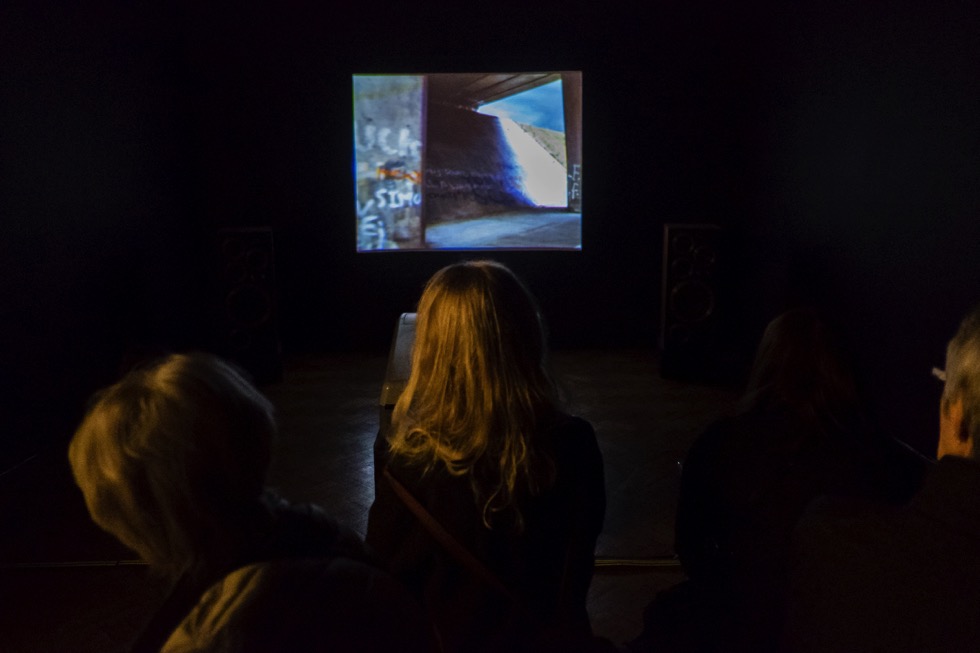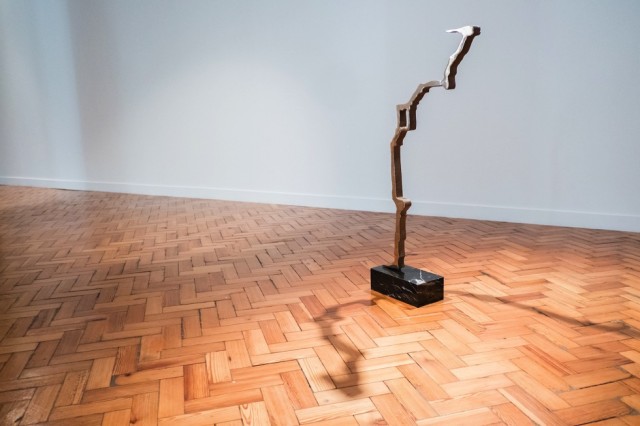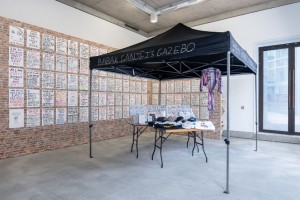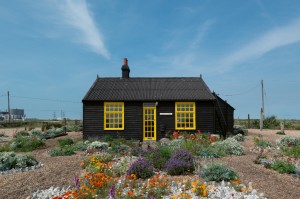Encountering A New Approach: Liverpool Biennial Comes To Bury

Brexit, riots and doorways to another realm: Sara Jaspan finds new meanings and contexts in the next stop of Liverpool Biennial’s Touring Programme, re-titled as Encounters…
Time Travel was perhaps the most intuitive of the six episodes around which last year’s Liverpool Biennial was structured. And it was with this theme in mind that I held some reservations about the organisation’s inaugural Touring Programme, which presents a number of the 2016 works in a different light this year: namely, at six separate art venues across the North West. Was it a risk? As with other touring shows, would it be a case of same work, different place – a rather uninteresting repetition? Or would something more thought-provoking emerge?
Arriving at Bury Art Museum & Sculpture Centre to visit one of the first iterations of this initiative – a group show of artists Céline Condorelli, Audrey Cottin, Mark Leckey and Rita McBride entitled Encounters (1 April–9 September 2017) – I was relieved to find the latter was the case. Encounters is very much an independent exhibition in its own right, bringing new meanings and contexts to the selected works, and with this a wider set of questions around the politics of display. Stepping into the gallery, the mood is calm, reflective and serene. A far cry from the chaotic festival whirlwind that gripped Liverpool last summer.
Speaking to the exhibition’s curator, Susan Lord, she explained that this differentiation had been important to both organisations from the outset. Bury Art Museum & Sculpture Gallery has, for the last decade, been developing a model of internationalism, exporting its own shows to other venues around the world, and very rarely accepting imports in return. While their participation in the Biennial tour bucks this approach, Lord made clear that “each venue had the freedom to select which works they wanted to show, and we went to great lengths to only choose ones that responded to the history of our space and the people of Bury. After all, Biennial 2016 was so specifically tied to its own locality, it would have been impossible to have attempted anything else.” The combination of pieces they went for threads a very interesting narrative.
Those who visited the 2016 festival and entered the great Collider by Andreas Angelidakis in Cains Brewery will recall finding the Children’s Episode at its centre, featuring Condorelli’s large, geometric orange structure. This structure was in fact one of many “portals” planted throughout the city, and had a small doorway intended only for children to pass through, thereby entering another realm of their own invention. Shown at Bury Sculpture Centre, however, the work’s escapist feel is overlaid by a rather more charged context.

The Centre is a relatively recent addition to the museum, converted in 2014 from part of Bury Library as a result of cuts to services in the area. The move sparked controversy, with even a small protest occurring on the night of its opening. Lord emphasised how committed the museum remains to not “shying away from the complexity of this past” when curating in the space.
“Presented here, Condorelli’s work was conceived of more as a reflection on how doorways can operate as both mechanisms and symbols of inclusion or exclusion,” she added, “while their design can encode complex social hierarchies”. Though such implications could raise eyebrows, the piece itself offers such a joyful invitation that it’s hard to resist ducking through. If you try, no gallery attendant will stop you. The door is, in fact, open to all.
Near to Condorelli’s portal lies a mammoth work by French artist Cottin, waiting to be “activated”: its title, Lift Me, offers some clue as to how (pictured, above). The piece, which consists of a series of long plastic tubes connected by rope, is a “performative sculpture” that requires the collaborative effort of at least eight visitors to resurrect it into a three-dimensional cubic structure. Cottin is inspired by the French Fluxus artist Robert Filliou’s belief that “everybody is perfect,” and her work is often centred around her search for a perfect collaboration with the people she encounters.
Lord told me that this principle is where the exhibition’s title comes from – again holding some relationship with the politics of the area. Bury voted in favour of Brexit and the museum staff are very conscious of this. She describes her vision of Lift Me as a positive statement about how we should progress into the future: building – not withdrawing from – relationships with others. Lord’s position falls closely in line with that of the museum itself. The Sculpture Centre is an area ring-fenced for showing work solely by international artists, thus upholding a sense of globalism; and their unusual partnering with the Biennial was underpinned by its global standing. Manager Tony Trehy also outlined plans for a summer exhibition entitled Foreigners, intended in response to Trump and Brexit as a gesture of “cultural action that defies fear with hope.”

That’s not to suggest that Bury Art Museum & Sculpture Gallery ignores the town’s own values or identity. On the way upstairs to where Leckey’s film Dream English Kid 1964–1999 AD )pictured, top) plays, you pass through the Bury Photographic Society annual exhibition, which forms part of the museum’s wider commitment to permanently showing work by local artists. Fittingly, Dream English Kid is heavily imbued with the spirit of the North-West. Made up of archival footage taken from television shows, advertisements and music online, it is intended as a record of the artist’s life growing up in and around Merseyside between the 1970s and 1990s. It captures many of the riots that took place in the region during that period. And “as well as featuring the famous Eric’s nightclub” Lord notes, “you also see The Met [Derby Hall] in Bury, where Ian Curtis from Joy Division made one of his last stage appearances.”
While McBride’s Perfiles – a series of branch-like metallic forms positioned throughout the Centre (pictured, above) – hold less of a clear local connection, they do share an interesting relationship with the architecture of the gallery. Each one depicts the outline of houses in Pompeii, described in the Encounters interpretation as “sculptural memories of buildings consumed by time.” Walking through the museum, it is hard not to also admire its impressive Edwardian features, which have been carefully preserved throughout the extensive renovation works carried out to modernise the space. Elaborate ceiling cornices, grand arches and stained glass panels intersperse the white walls and pared-down aesthetic in which McBride’s rather modern “sculptural memories” are presented, somehow echoing the content of the work.
Like all the pieces in the exhibition, these Perfiles seemed to carry much greater weight once removed from the somewhat hectic conditions of Biennial 2016. As such, the Bury exhibition – and Biennial Touring Programme as a whole – presents an interesting counter-point to the curatorial thinking behind the previous year’s festival. While the diverse range of original, unorthodox locations (Cains Brewery, the iconic ABC Cinema, Blade Factory, and more) was intended to form as much a part of the overall experience of the work as the individual pieces themselves, the effect did at times detract. At Bury, the works seem to speak back to their surroundings, rather than being spoken to.
But to return to my initial question – can a touring exhibition offer something more? – this new, site-responsive model certainly does. In addition, the value of extending the reach of the Biennial’s 2016 commissions to new areas and audiences is, of course, indisputable. The tour line-up includes Barnsley, Brierfield, Bury, Leeds, Leigh and Rochdale, where hopefully more people will experience the work who might not necessarily travel to Liverpool to see art. Lord tells me that that the programme has also been a great opportunity to develop new links between the partner venues themselves: “the Biennial got us all sat around the same table for what I think must have been the very first time, and I’m sure new collaborations will come out of that.” An exciting prospect indeed.
Sara Jaspan
Encounters runs from 1 April to 9 September 2017 at Bury Art Museum & Sculpture Centre, Bury, Greater Manchester
This original article has been co-commissioned by Liverpool Biennial and The Double Negative to celebrate the Biennial’s Touring Programme in 2017-8. The tour sees artworks by leading international artists who exhibited at the 2016 Biennial travel to six different locations in Northern England: Barnsley, Brierfield, Bury, Leeds, Leigh and Rochdale. Read more here
Images, from top: Mark Leckey, Dream English Kid 1964 – 1999 AD, 2015. Installation view at Encounters, Bury Art Museum & Sculpture Centre. Activating Audrey Cottin, Lift Me, 2011 at the launch of Encounters, Bury Art Museum & Sculpture Centre. Rita McBride, Fortuna Virilis, 2010. Installation view at Encounters, Bury Art Museum & Sculpture Centre. Photo: Pete Carr © Liverpool Biennial





